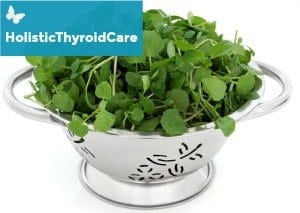Therapeutic Benefits of Watercress
With its rich resources of vitamins C and A and vital minerals, such as potassium and calcium, it’s no wonder that watercress (Nasturtium officinale) has long been appreciated for its nutritional content. Originally believed to cure disorders of the brain, the herb was prescribed by Greek physicians as early as the 5th century B.C. In the 1870s, a tuberculosis epidemic struck those who were working on the transcontinental railroad, and, once again, the delicate bitter herb was prescribed.
Today, it’s the vitamin, iron and iodine content that makes watercress such an effective remedy for viral infections, indigestion, high blood sugar, and coughs.
The tiny green bundles are usually gathered in the summer and used in soups and salads because of its delicate, yet sharp, flavor. In fact, the Latin name for watercress comes from nasus totrus and means “tormented nose,” a fitting nickname for its bitter scent and taste.
Stimulates Digestion
Like other members of the mustard family, watercress contains a high level of sulfur compounds that stimulate gastric juices and enhance the appetite. It is a diuretic as well, cleansing the kidneys and helping the body unload toxic wastes from the tissues and blood. To make a tangy salad, mix watercress leaves with dandelion leaves and arugula. Toss with lemon juice and 1/2 tsp. of grated ginger. Season with sea salt.
Additional Therapeutic Benefits
The high content of vitamin C and minerals makes the herb valuable in treating colds, coughs, and bronchitis. In addition, it contains vital nutrients that help maintain healthy functioning of both the thyroid and endocrine glands. This makes it an excellent remedy for poor vitality, listlessness, and fatigue.
[UPDATE] What’s also fantastic news for people with Hashimoto’s hypothyroidism is that antioxidant-rich plants like watercress can help prevent exercise-induced oxidative stress and counter the DNA damage that results from free radical production after exercise.
Components
Watercress contains a wealth of vitamins A, B2, B6, C and E; naturally occurring iodine for endocrine function; potassium for performance; and iron for blood production. Other components include copper, phosphorus, calcium, indoles and mustard-oil glycosides. Caution: Eating large amounts of the bitter herb over an extended period of time may irritate the lining of the stomach.
Skin Rashes
The delicate green is useful in treating eczema and acne. Place clean, fresh leaves in a juicer and puree. Mix 1 part fresh watercress juice with 4 parts filtered water. Suggested use is to take 3 teaspoons daily.
Extra Tip
Chewing watercress is a time-tested remedy for bad breath. It also helps to relieve and strengthen inflamed gums.
Kitchen Hints
Watercress can be obtained almost year-round. To thrive, it must grow in the cleanest of water, so most of the watercress available on store shelves is now cultivated. It is wise to use only commercially-grown organic watercress plants, as wild watercress may carry disease-causing organisms.
When buying watercress, look for fresh leaflets of an even, dark-green hue. If you find any yellow leaves in the center of the bunch, chances are it is no longer fresh. Store watercress with the stems intact. Place the stems in cold water and refrigerate.
Watercress is fragile and does not keep well. Use within 1 day of purchase for optimal flavor. Running water will easily bruise watercress leaves. To clean, fill a bowl with cold water, add the leaves and soak. Do not blot the leaves dry; use a salad spinner or gently shake dry instead. You will have 1/2 the volume purchased once you have trimmed and washed the herb.
Watercress tea is effective for indigestion. For relief pour 1 cup of boiling water over a hefty handful of fresh watercress leaves. Steep for 5-10 minutes and strain. Drink 1 cup following meals or whenever symptoms occur.
You May Also Enjoy
Gluten Free Cucumber Watercress Tea Sandwiches
References
https://www.ncbi.nlm.nih.gov/pubmed/22475430
https://www.ncbi.nlm.nih.gov/pubmed/21442676
The information presented has not been evaluated by the Food and Drug Administration and the information provided is not intended to diagnose, treat, cure, or prevent any disease. The following information serves as guidelines to assist the individual in using preventative health knowledge effectively for improving overall health.
- These guidelines should NOT substitute for sound clinical judgment or conventional therapies that may be needed for a particular individual.
- Before starting on any product read carefully and consider all directions and warnings on the product label.
- Before making any lifestyle changes please consult with your physician.
- The guidelines offered are intended to assist the individual in achieving optimal health and well-being.




